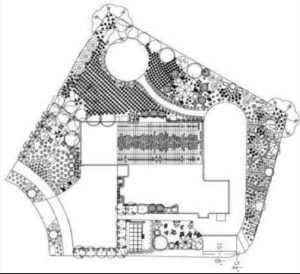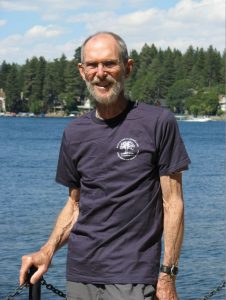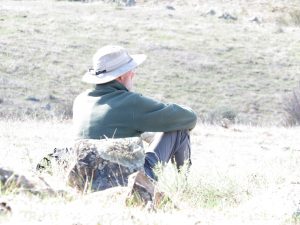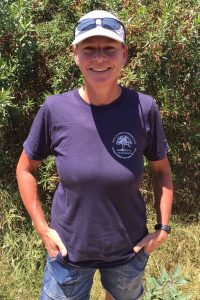 by Kerry Martin, BTN Intern
by Kerry Martin, BTN Intern
After watering all the plants in the nursery on Tuesday, we were off on another landscape maintenance adventure this time in Santa Ana (coastal sage zone) with Reggie leading the team (Ryan, Kennedy and I). This particular front yard was designed by Lori and installed by the BTN team the first quarter of this year. I was blown away by how fast the native plants had grown in and how the different foliage textures and colors created such a harmonious feel. In addition to installing a flowing brick walkway, the plants were intentionally planted on natural looking berms, much like they would look in nature. The blooming milkweed, white and Cleveland sage, California fuchsias, wooly blue curls, common yarrow, monkeyflowers and bush sunflowers set the entire yard ablaze with alluring color, a true celebration of the diversity of California’s flora. Complementing the grasses, sages, wildflowers etc. were 2 young California sycamore trees.
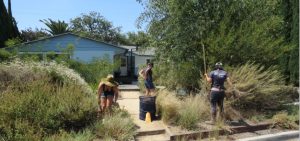 The plant selection also created an inviting environment for wildlife (hummingbirds and butterflies in particular). In addition to learning from Reggie and Kennedy about identifying the various plants, I learned how to tell the difference between a monarch and queen butterfly, the later having orange with white spots on the top of its wings but otherwise looking just identical, and why butterflies have spots that look like eyes on the back of their wings.
The plant selection also created an inviting environment for wildlife (hummingbirds and butterflies in particular). In addition to learning from Reggie and Kennedy about identifying the various plants, I learned how to tell the difference between a monarch and queen butterfly, the later having orange with white spots on the top of its wings but otherwise looking just identical, and why butterflies have spots that look like eyes on the back of their wings.
After the yard tour was complete and the “before” pics snapped, we checked to ensure the irrigation was working properly and adjusted the emitter heads where the flow was too low or high – one click to the left or right. After receiving excellent and funny instructions on how to properly use a post hole digger, we set about planting 3 purple three awn grass plants in a bare spot on top of a DG berm. Reggie demonstrated the proper way to plant native grasses. We then set up a new drip line and placed an emitter uphill and just outside the root ball of each plant. Next, we planted 2 sedges by the front door, breaking apart the root ball so that they could be planted in an arc shape with enough room between for the client’s German Shepard to still rest comfortably in her favorite spot! (This type of grass is the only native grass wherein the root ball can be tampered with; otherwise, it’s key to keep intact when planting). The sedges were root bound so were difficult to break up so we also received a lesson on how to carefully break apart the rhizome laterals in order to, in this instance, get the plant in the desired arc shape.
On Thursday, watering the plants first thing in the morning was again top priority. There is definitely a learning curve to watering efficiently whilst not getting the leaves wet. And, I mustn’t forget to more carefully check for kinks in the hose line before scratching my head about why the water is all of a sudden not flowing! Once all the watering was complete, Albert showed me how he was installing the new irrigation for the 4″ pot tables in the back. Kennedy and I then set about removing the blue tarp from the top of the small greenhouse where we grow milkweed, and began to replace it with the shade cloth that had been measured and gusseted by Trina. I also had the pleasure of meeting John, who was lending a hand with putting manzanita seeds into soil in a tray that was going to receive a hot water treatment. I’m very much looking forward to learning much more about propagation including growing plants from seeds and the various techniques used to ensure healthy organic plant growth.
After watering the nursery plants the next Tuesday with Kennedy, we both took the coastal sage scrub quiz administered by Trina. The fact that I can now identify the different indicator species from pictures and even spell the scientific names correctly was very gratifying. I’m getting a head start on similar homework assignments as I’m so enjoying learning how to identify the different native plant species. Trina, Ryan, and Kennedy then set off to Costa Mesa for a landscape maintenance assignment, while I stayed in the nursery to give Albert a hand with cutting PVC pipe and gluing on tees to build the irrigation manifolds for the 1 gallon plant tables in the back.
Another extremely educational week for me! Thanks Reggie and Trina for sharing your knowledge with us all.
 Back to Natives is hosting a native plant tea workshop on, Saturday November 12, 10AM – 12PM. Craig Torres, a descendant of the Native American Tongva people who inhabited the Los Angeles Basin, will talk about the uses of different native plant teas, provide materials to make tea bags, and have sample teas to drink (bring a small cup!) Register and prepay at backtonatives.org.
Back to Natives is hosting a native plant tea workshop on, Saturday November 12, 10AM – 12PM. Craig Torres, a descendant of the Native American Tongva people who inhabited the Los Angeles Basin, will talk about the uses of different native plant teas, provide materials to make tea bags, and have sample teas to drink (bring a small cup!) Register and prepay at backtonatives.org.
